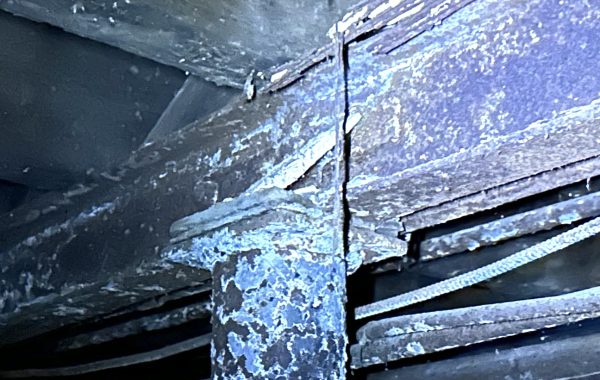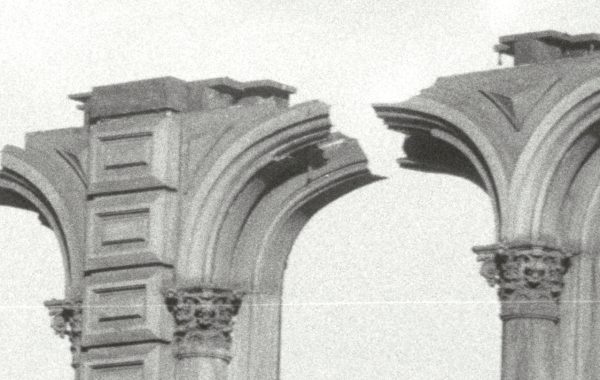That picture, of the 157th Street Station on the 1 train, shows the unevenness of adoption of new technology. It’s right there, can’t you see it?
Here’s a close-up with the contrast cranked up high:
You see that thing in line with the column and below the platform lip? That’s cast iron. That’s the metal technology that New York embraced in the 1850s and only abandoned after several disasters showed that it was ill-suited to structures with dynamic loading, which is to say bridges and buildings. But it’s okay here…
The original line of the Interborough Rapid Transit ran from the now-closed City Hall station to 145th Street. It was always meant to grow beyond that, and 157th Street was the first new station added, in November 1904. This station was designed as part of the original system, so the engineering took place around 1900 or 1901, before cast iron was completely abandoned. We’re seeing two main pieces: a round column and a column base. Starting at the top of the close-up, we’ve got a masonry column enclosure covered with tile, then the edge of the concrete platform (with the yellow warning stripe), a beam supporting that edge, running below it and covered with dirt, a seated connection for that beam in line with the column (in the form of a T, with the actual seat as the T crossbar and a stiffener as the T stem), a short stretch of circular cast-iron column, a column splice (in the form of two horizontal-plane circular plates) and then the column base proper, which has a bunch of sloped vertical plates leading down to a base plate. The seated connection is cast iron and integral with the column, the top plate of the two that make up the splice is integral with the column, and the bottom splice plate is integral with the base. You can build up a base like that from steel plate but that requires welding technology that wasn’t ready for use in 1904; I’ve only ever seen this particular geometry in cast iron. I used to think of them as cast-iron spiders because there are eight vertical plates.
The load on this column is overwhelmingly dead load: the weight of the soil above the station, the weight of the station roof, and the weight of the platform. The live load of people on the platform and even traffic on the street is small by comparison; the street load is also spread out from having to travel though some six to ten feet of soil before It gets to the station roof. Cast-iron columns are at their best when subjected to static or mostly static loading, which is the situation here.
Why didn’t the IRT’s engineers use steel, the modern technology they were so successful with so many other places? Value engineering. Cast-iron columns are cheaper than steel and so were a good idea where they could be safely used: in stations, where train speeds were slower in stations and therefore there was less dynamic loading. The future was here, but unevenly distributed.





You must be logged in to post a comment.